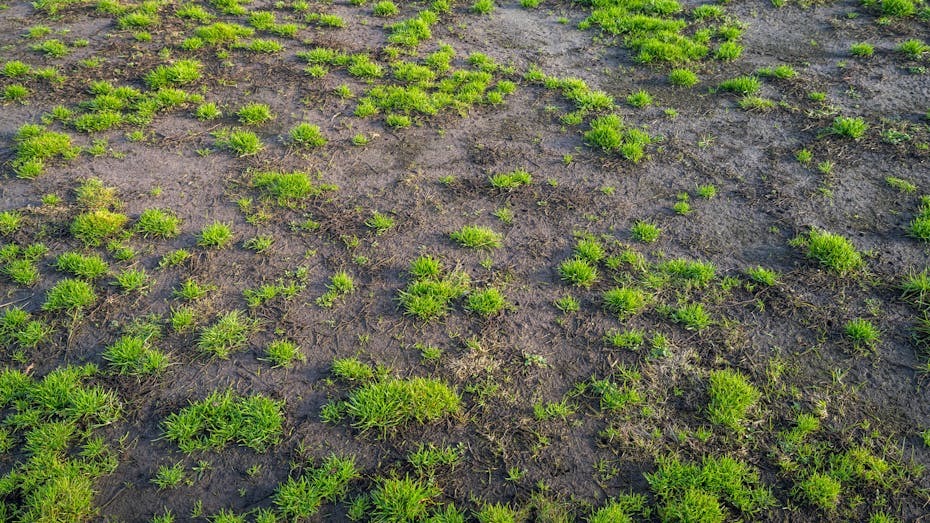
Spring Lawn Repair
After a dismal winter your lawn can be in a terrible state. Help is at hand here!
It is very common to have to repair some areas of lawn after winter. This is standard practice on the golf course and if you have lawns or parts of lawns that recede over winter then re-seeding will be required.
Why does grass thin?
When the conditions for life start to become borderline then the lawn will thin as individual grass plants die. This usually happens over winter when the total amount of sun light reduces considerably. Throw in a building, tree of fence on the sky line and the sun may never get above it for 5 or 6 months leaving areas of lawn in permanent shade and dampness.
Some winters can be cold and dry which means more light than average so the damage is not too bad. If on the other hand the winter is cloudy and wet you'll have double damage from less light and possibly drowning grass plants. And just when you thought it couldn't get worse if the winter is mild then you could find moss taking over as the grass keels over and withers away. The extreme effects of this combination of weather conditions can be seen in the image. This occurred over December and January 2015/16 and again 2019/20.
Equally problematic, though in perhaps smaller areas, is the summer die back usually around trees when leaves block out the sun and the tree roots suck up all moisture from the soil leaving nothing for nearby plants including the lawn!
How to repair seasonal die back and thinning
You'll pretty much follow the standard procedure for over seeding which you'll find in the Raking and Scarifying topic. If moss has moved in then the Moss Control topic would be a better place to be.
In Summary:
- Remove debris/thatch/moss and open the soil surface by raking or scarifying
- Over seed the whole area so the new seed blends with the existing grasses
- Ensure good seed to soil contact
- Fertiliser - if this is part of an established but thinned lawn you are best off with one of the fertilisers at the bottom of this article
- Ensure adequate supply of water - in other words don't let it dry out
Weed Invasion
The job becomes more problematic if the area has become inundated with weeds. As you are likely to be doing the repair in early spring most selective lawn weedkillers (safe for grass) will not work. This means manually removing the weeds or using glyphosate which kills everything including grass. Glyphosate has no residual effect so seeding is not impacted. Once the weeds are dying which can take several weeks in cool conditions you can then scarify/rake the area and continue as suggested.
An alternative approach is to manually remove the larger weeds and leave the rest. Scarifying or raking will remove some of the leaves off the remaining weeds still allowing a good seed bed. Allow at least 2 months after seed germination then apply a selective weedkiller. This Weedol product is safe on young grass.
What seed is best?
If this is a one off event due to peculiar weather conditions then your seed choice should be what is best for your use rather than worrying about getting a grass that will survive in damp shady conditions. The chances are it won't happen again (not for a while anyway) and if the summer is hot and dry you'll have to re-seed yet again!
If this is a regular event; perhaps you have buildings or fences that block winter light or you're in a wet part of the country then a change of grass variety may go someway to reducing the problem though be prepared to make this form of lawn repair an annual event! For areas that have good moisture most of the year (usually around fences and buildings) use Shadygreen grass seed. For areas that go from shady damp in winter to dry in the summer use Staygreen grass seed.
Timing is important
These problem areas may, due to fences and buildings not get any direct sunlight until perhaps May which means soil temperatures will be lower than the rest of the garden. Therefore don't seed too early and perhaps start a week or two later than normal when temperatures have warmed a little more with mid to late April being a good target if the weather forecast confirms warming temperatures.
If the area to be seeded is around trees then get onto it as soon as conditions come right as you'll want to have your newly seeded areas well established before the tree canopy fills out. If your problem is around trees but at the end of summer then best re-seed in spring as leaf fall will compromise any autumn sown seedlings.
Preventing Further Problems
Reducing shade and preventing excess water going into the lawn should be your main focus. Therefore where possible:
- Cut back all over hanging greenery
- Can fences be lowered and shade causing items be moved
- If tree shade is a problem reduce tree height and open up the canopy if
- Prevent rain water from running off hard surfaces into the lawn
Sometimes it is impossible to change the environment that causes issues. This may mean living with the problem and therefore over seeding every spring.
Follow-on from Summer Drought
On occasions after a dry summer there is insufficient time or resources (hose pipe ban) to repair the lawn before winter. This means a sick damaged lawn is quite possibly going to get worse with moss and weeds being the main survivors. This doesn't mean you should change your approach to repair but we would recommend reading this article to get a good grasp of the problem.